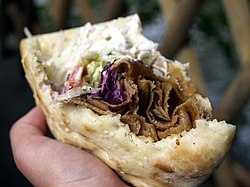Shawarma
This article needs additional citations for verification. (January 2016) |
 Shawarma in a pita | |
| Type | Meat |
|---|---|
| Place of origin | Ottoman Empire |
| Region or state | Middle East |
| Main ingredients | Meat: lamb, chicken, turkey, beef Sandwich: Shawarma meat or shaorma falafel, pita or wrap bread, chopped or shredded vegetables, pickles and assorted condiments |
Shawarma or Shawurma is a Levantine meat preparation, where lamb, chicken, turkey, beef, veal, buffalo meat, or mixed meats are placed on a spit (commonly a vertical spit in restaurants), and may be grilled for as long as a day.[1][2] Shavings are cut off the block of meat for serving, and the remainder of the block of meat is kept heated on the rotating spit. Shawarma can be served on a plate (generally with accompaniments), or as a sandwich or wrap. Shawarma is usually eaten with tabbouleh, fattoush, taboon bread, tomato, and cucumber. Toppings include tahini, hummus, pickled turnips, and amba.
Similar dishes in the region include Turkish döner kebabs and Greek gyros.[3]
History
Though grilling meat on a skewer has ancient roots in the Eastern Mediterranean with evidence from the Mycenaean Greek and Minoan periods,[4][5][6] grilling a vertical spit of stacked meat slices and cutting it off as it cooks was developed in the 19th century in Ottoman Bursa current day Turkey.[7] According to some sources, the Middle Eastern shawarma, Mexican tacos al pastor, and Greek gyros are all derived from the Turkish döner kebab, which was invented in Bursa in the 19th century by a cook named Hadji Iskender.[8]

Etymology
Shawarma is an Arabic rendering of Turkish çevirme [tʃeviɾˈme] 'turning', in reference to the rotisserie-cooked nature of the meat, which "turns" around an axis.[9] Similar naming conventions apply to the Turkish döner and the Greek gyros, both of which reference the turning action of the associated cooking mechanism.
Preparation


Shawarma is made by alternately stacking strips of fat and pieces of seasoned meat on a vertical spit. An onion, a tomato, or a halved lemon is sometimes placed at the top for decoration. The meat is roasted slowly on all sides as the spit rotates in front of, or over, a flame for hours (see rotisserie). Gas or electric heat is used; formerly, there was a cage holding burning charcoal or wood. Some restaurants offer two or more meat selections; many have just one.
The meat is shaved off the stack with a large knife, an electric knife or a small circular saw, dropping to a circular tray below to be retrieved. Shawarma is eaten as a fast food, made up into a sandwich wrap with pita or lavash together with vegetables and dressing. A variety of vegetables come with the shawarma which include: cucumber, onion, tomato, lettuce, eggplant, parsley, pickled turnips, pickles, rhubarb, cabbage or French fries.
Dressings include: tahini (or tahina), amba sauce (pickled mango with chili), hummus, or those flavored with vinegar and spices such as cardamom, cinnamon, and nutmeg. Chicken shawarma is served with garlic mayonnaise, toumaia (garlic sauce), pomegranate concentrate, or skhug (a hot chili sauce).
See also
- Levantine cuisine
- Arab cuisine
- Israeli cuisine
- Doner kebab
- Gyros
- Kati roll
- Shish taouk
- List of sandwiches
- Street food
- Tacos al Pastor
References
- ^ Philip Mattar (2004). Encyclopedia of the Modern Middle Eastern (Hardcover ed.). Macmillan Library Reference. p. 840. ISBN 0028657713.
Shawarma is a popular Levantine Arab specialty.
- ^ John A La Boone III (2006). Around the World of Food: Adventures in Culinary History (Paperback ed.). iUniverse, Inc. p. 115. ISBN 0595389686.
Shawarma - An Arab sandwich similar to the gyro.
- ^ Aglaia Kremezi and Anissa Helou, "What's in a Dish's Name", "Food and Language", Proceedings of the Oxford Symposium on Food and Cookery, 2009, ISBN 190301879X
- ^ Ancient Greeks Used Portable Grills at Their Picnics but,
- ^ To Vima (in Greek), 6-2-2011 (picture 2 of 7)
- ^ Wright, Clifford A. (1999). A Mediterranean Feast. New York: William Morrow. pp. 333.
- ^ Kenneth F. Kiple, Kriemhild Coneè Ornelas, eds., Cambridge World History of Food, Cambridge, 2000. ISBN 0-521-40216-6. Vol. 2, p. 1147
- ^ Kenneth F. Kiple, Kriemhild Coneè Ornelas, eds., Cambridge World History of Food, Cambridge, 2000. ISBN 0-521-40216-6. Vol. 2, p. 1147.
- ^ Terrorism, the Origin and the Sources: An Anthology of Poetry Ambigrams and Political Oratories, p. 307.
External links
 Media related to Shawarma at Wikimedia Commons
Media related to Shawarma at Wikimedia Commons

